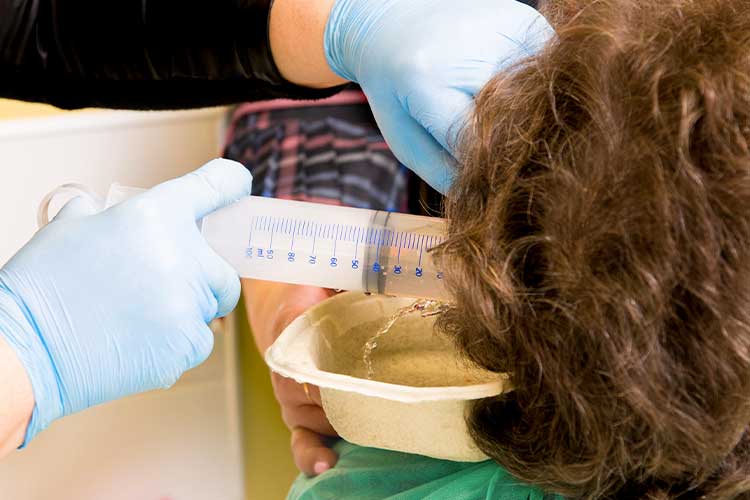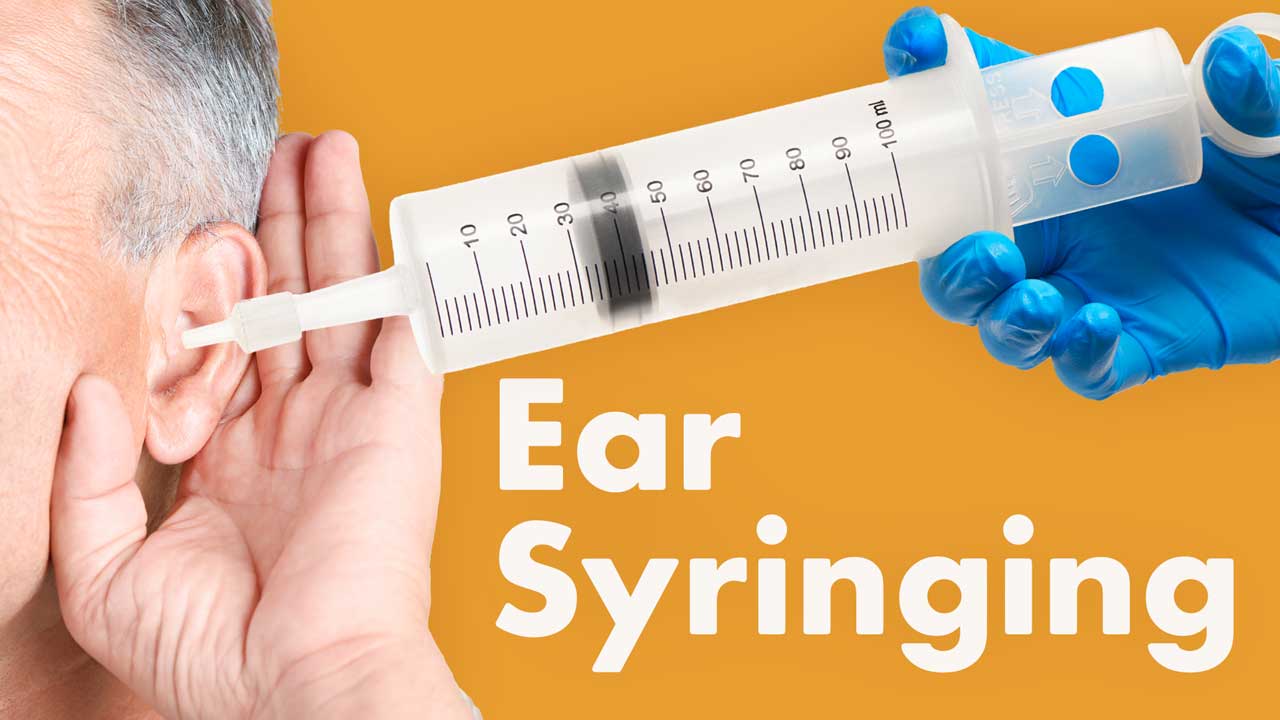Ear syringing, also known as ear irrigation, is a procedure commonly used to manage cerumen impaction (ear wax build-up). It involves inserting saline or sterile water into the ear canal in an attempt to flush the ear wax out (Poulton et al. 2015; Nall 2019).
Ear syringing is a common procedure that’s estimated to be performed at least twice per week by most general practitioners (Poulton et al. 2015).
However, despite being considered effective and safe, ear syringing causes major complications in 1 out of 1,000 patients and is associated with various risks (Poulton et al. 2015).
How can ear syringing best be performed, and are there any safer alternatives?
What is Cerumen Impaction?
Cerumen (ear wax) is a sticky secretion produced by the glands in the ear canal. Its function is to clean and protect the ear by trapping dirt and pathogens, preventing them from travelling further into the ear and causing infection (Better Health Channel 2022; Healthdirect 2023).
Typically, ear wax exits the ear on its own along with dirt and dead skin cells. This migration is assisted by activities such as chewing and talking (Healthdirect 2023).
While ear wax is a crucial mechanism enabling self-cleaning of the ears, in some cases, it may accumulate in the ear canal and cause symptoms such as:
- A feeling of fullness in the ear
- Hearing impairment
- Earache, pain or itching
- Tinnitus (ringing in the ear)
- Dizziness.
(Healthdirect 2023)
This build-up is known as cerumen impaction. It’s usually harmless, but can be uncomfortable and annoying (Better Health Channel 2022).

Risk Factors For Cerumen Impaction
Factors that may increase the risk of an ear wax build-up include:
- Naturally producing a large quantity of ear wax
- Having narrow or hairy ear canals
- Working in dirty or dusty environments
- Regularly wearing headphones or hearing aids
- Attempting to manually clean ear canals with cotton buds or fingers, which can push wax further into the ear
- Older age, as ear wax hardens with age and doesn’t fall out as easily (cerumen impaction is found in about 57% of older adults compared with 5% of healthy younger adults)
- Otitis externa
- Having certain skin or scalp conditions.
(Better Health Channel 2022; Healthdirect 2023; Poulton et al. 2015; NHS 2024)
When is Ear Syringing Indicated?
Cerumen impaction is normal and only requires treatment if it’s causing symptoms (Poulton et al. 2015).
The first-line treatment is typically a cerumenolytic - an agent used to soften ear wax and help it fall out on its own. This will come in the form of water or oil-based eardrops (Poulton et al. 2015; Better Health Channel 2022).
In about one-third of cases, the ear wax clears on its own without treatment in under five days (Poulton et al. 2015).
If the impaction is more significant or cerumenolytics have been unsuccessful, ear syringing is another option that can be considered (Better Health Channel 2022).
Unlike other treatment options, such as microsuction, ear syringing can be performed by non-clinicians (Schumann et al. 2022).
Ear syringing is not suitable for patients who:
- Have any signs or symptoms of otitis externa or otitis media
- Have a past or present perforation of the tympanic membrane
- Have a history of ear surgery, middle ear disease or inner ear issues (e.g. vertigo)
- Have unilateral deafness
- Have a foreign body in their ear canal
- Are uncooperative (e.g. some children)
- Are unable or unwilling to stay still
- Cannot sit upright
- Have impacted wax in their only hearing ear, or better hearing ear (where there is hearing impairment).
(Poulton et al. 2015; Schumann et al. 2022)
Extra care should be taken for patients who have a history of recurrent otitis externa or tinnitus, are immunocompromised, or are at an increased risk of infection (Poulton et al. 2015).
What Are the Risks of Ear Syringing?
Ear syringing is generally safe, but there is a risk of side effects and complications, including:
- Vertigo
- Tinnitus
- Nerve irritation
- Damage to the skin of the ear canal
- Tympanic membrane perforation
- Middle ear damage
- Increased risk of infection (e.g. otitis media or otitis externa), especially if irrigation fluid is retained in the ear.
(Poulton et al. 2015; Schumann et al. 2022)
How to Safely Perform Ear Syringing

- Obtain a detailed history of the patient. Perform a thorough physical exam of the ear using an otoscopy in order to check that the tympanic membrane is intact. You should also assess for any other abnormalities.
- You may wish to advise the use of a cerumenolytic agent prior to the procedure to soften the ear wax.
- Explain the procedure to the patient, including all potential complications.
- Gain the patient’s consent.
- Perform hand hygiene.
- Gather equipment, including an irrigation device (e.g. large syringe, mechanical jet irrigator or pulsating water device), irrigation fluid (sterile water or saline) and a basin to catch the fluid and ear wax.
- The irrigation fluid needs to be warmed to near body temperature prior to the procedure. If the fluid is too hot or cold, it may cause nausea or dizziness when inserted into the ear.
- Perform hand hygiene.
- Place the fluid into the irrigation device.
- Instruct the patient to sit upright.
- Insert the irrigation device into the ear, ensuring the tip does not pass the outer one-third of the ear canal (a depth of approximately 8 mm).
- Hold the basin against the skin below the patient’s ear to catch the fluid during irrigation.
- Inject the fluid towards the edge of the ear wax. Do not aim the fluid at the tympanic membrane, and avoid injecting too quickly as this can cause pain, bleeding or trauma.
- If the patient begins to experience any of the following symptoms, the procedure must stop immediately, and the ear canal and tympanic membrane should be assessed:
- Sudden pain
- Tinnitus
- Hearing loss
- Nausea
- Dizziness
- After irrigation, assess the external canal and tympanic membrane for any damage.
- Perform hand hygiene and documentation.
(Poulton et al. 2015; Schumann et al. 2022)
When to Escalate Care
Care may need to be escalated if:
- Irrigation fails to remove the ear wax after multiple attempts
- The patient experiences pain or bleeding upon irrigation
- Symptoms persist even after successful ear wax removal
- The patient has contraindications that make irrigation unsuitable
- There is abnormal tissue in the patient’s ear canal
- There are any other concerns.
(Poulton et al. 2015)
Other Options for Ear Wax Removal
The other procedure commonly used for ear wax removal is microsuction, where a small vacuum-like device is used to suction the wax out of the ear (Yetman 2021). Microsuction is effective, well-tolerated and less likely to cause complications than irrigation as it’s a dry procedure that doesn’t expose the ear to moisture (Poulton et al. 2015).
It’s also quicker and can be performed on some patients who are contraindicated for ear syringing (Yetman 2021).
However, unlike ear syringing, microsuction is less widely available and is typically only performed in outpatient ear, nose and throat (ENT) clinics (Yetman 2021; Poulton et al. 2015).
Microsuctioning also needs to be performed by an appropriately qualified specialist.
Preventing Ear Wax Buildup

Patients should be encouraged to:
- Avoid cleaning the ear canals with any objects poked into the ear (e.g. fingertips, cotton buds, hair clips) as this can push the wax further into the ear or cause damage
- Use cerumenolytics when required (according to directions)
- Only clean the outer ear
- Treat any inflammatory skin conditions that are present.
(The Royal Victorian Eye and Ear Hospital 2022)
Test Your Knowledge
Question 1 of 3
Why must the irrigation fluid used in ear syringing be near body temperature?
Topics
Further your knowledge
References
- Better Health Channel 2022, Ear Wax, Victoria State Government, viewed 1 May 2025, https://www.betterhealth.vic.gov.au/health/conditionsandtreatments/ear-wax
- Healthdirect 2023, Ear Wax, Australian Government, viewed 1 May 2025, https://www.healthdirect.gov.au/ear-wax
- Nall, R 2019, ‘What to Know About Ear Irrigation’, Medical News Today, 25 July, viewed 1 May 2025, https://www.medicalnewstoday.com/articles/325857
- National Health Service 2024, Earwax Build-Up, NHS, viewed 1 May 2025, https://www.nhs.uk/conditions/earwax-build-up/
- Poulton, S, Anderson, D, Bennett, D & Yau, S 2015, ‘Ear Wax Management’, Australian Family Physician, vol. 44, no. 10, viewed 1 May 2025, https://www.racgp.org.au/afp/2015/october/ear-wax-management
- The Royal Victorian Eye and Ear Hospital 2022, Ear Wax, The Royal Victorian Eye and Ear Hospital, viewed 1 May 2025, https://eyeandear.org.au/patients-visitors/fact-sheets/ear-wax/
- Schumann, JA, Toscano, ML & Pfleghaar, N 2021, ‘Ear Irrigation’, StatPearls, viewed 1 May 2025, https://www.ncbi.nlm.nih.gov/books/NBK459335/
- Yetman, D 2021, ‘What is Microsuction for Earwax Removal?’, Healthline, 18 March, viewed 1 May 2025, https://www.healthline.com/health/microsuction
 New
New 

